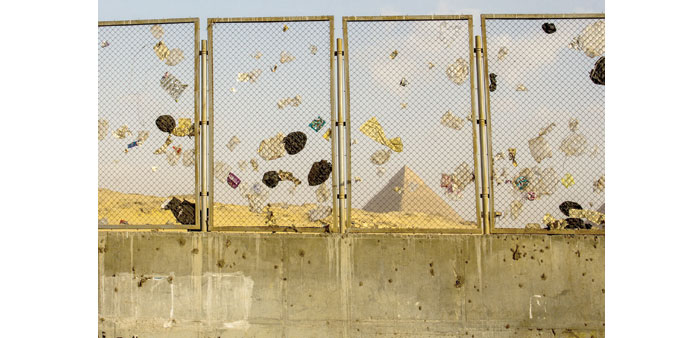NEGLECTED: Litter clings to the fence around the Giza Pyramids, near the town of Nazlet-el-Samaan.
Cairo-based photojournalist Roger Anis captures the sorry state of Egyptian tourism industry after the events of Arab Spring in a revealing series titled Revolution Up, Tourism Down. By Anand Holla
While the tourism industry of Egypt is famed for its immense variety and verve, it has been beset with troubles since the uprising four years ago – the latest blow coming in the way of the downing of the Russian airliner Metrojet over the Sinai Peninsula of Egypt that killed all 224 passengers and crew aboard.
With his telling series of images titled Revolution Up, Tourism Down, Cairo-based photojournalist Roger Anis, who works for the daily newspaper Al-Shorouk, shed light on the grim fallout of the uprising on his country’s tourism sector at the exhibition Stories of Change: Beyond the Arab Spring, which was recently held at Katara.
Be it the Great Pyramids of Giza, the ancient temples at Luxor or the beach resorts of Sharm el-Sheikh and other towns along the Red Sea, Egypt has been a popular tourist destination for decades on end. It was in 2010, the year before the ousting of President Mubarak, that the number of annual international visitors to Egypt hit an all-time high of over 14mn.
“The revolution and continuing unrest affected the tourist trade dramatically, with arrivals down to around 9mn in 2012, and – after a shaky recovery in the early months of 2013 – falling again after the ‘second revolution’. Visitors to Red Sea resorts accounted for a substantial portion of the arrivals. This region was the least affected by the unrest in Cairo and other cities, though reports of tourist kidnappings and attacks on security guards did affect visitor numbers,” says a note on the photo-story.
“But the ancient sites to the north remained off tourist itineraries, as foreign governments issued security warnings about visiting Egypt. Revenues from tourism decreased by 30% in 2011 – dropping by nearly €440mn in July and August 2013 alone – after the military’s removal of President Mursi. Calculated annually, this decline would amount to a fall of 1.5% of Egyptian GDP,” the note points out.
When Anis visited Luxor, a temple guard there, holding on to some hope for the future, told him: Tourism may get sick, but it will never die. Anis says, “Ever since the 2011 revolution, the number of people visiting Egypt has been on the decline – a serious situation in a country where almost a third of the population depends on tourism as a source of income. Hopes rose a little in the early months of the Mursi government, but were dashed again in the unrest surrounding his removal from power. Many countries and tour operators issued warnings to people to stay away from Egypt, and the reports of ongoing violent clashes in the cities, and of attacks and kidnappings on the Sinai Peninsula, must have made Egypt a very unattractive prospect to most visitors.”
As for those who made it, a night-time curfew, deserted tourist sites, and the sight of closed shops and markets could not have been very attractive, says Anis.
“The government became careless of cleaning and security at tourist sites, which detracted further from their allure. When I visited Luxor, there were barely 20 people at a temple I was told used to attract hundreds of sightseers daily; a tour guide in Hurghada told me that groups that had once numbered 200 to 400 people, had shrunk to just 30, and there were also only around 30 people watching the Giza pyramid sound-and-light show when I was there – an attraction that used to draw up to 1,200 viewers at a time.”
Anis is looking to move into documentary photography through photo stories and multimedia, and is currently working on a long-term project about street kids and women in Egypt. He has participated in exhibitions in Egypt and internationally, and his accolades include a Second Prize, Picture of the Year, in the 2011 Egypt Press Photo Awards, and Second Prize, Photo Story in the 2013 Egypt Press Photo Awards.
“The impact on people on the ground – the guides, guards, hotel workers, taxi drivers – has been severe, as it has on the supplementary tourist economy, on the souvenir sellers and camel owners offering rides,” Anis points out.
When he visited the Giza pyramids, he saw groups of desperate vendors and camel owners harassing the few tourists for trade, sometimes quite aggressively. “And all over the country, workers in the tourist trade have been laid off, or put on unpaid stand-by, as restaurants and hotels lie empty. Tourism has become one of the sacrifices we have had to make in Egypt in order to change,” Anis says.



